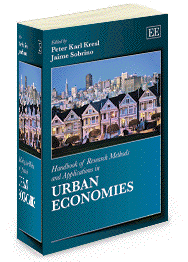Handbook Of Research Methods And Applications In Urban Economies
Peter Karl Kresl , Jaime Sobrino
Edited by Peter KarlKresl, Charles P. Vaughan Professor of Economics (Emiritus), BucknellUniversity, US and President, Global Urban Competitiveness Project and JaimeSobrino, El Colegio de México
Elgaroriginal reference
2013 544 pp Hardback 978 0 85793 461 1
2014 Paperback 978 1 78195348 8
ebook isbn 978 0 85793 4628

Description
‘It is obvious that cities have long been the focus of analysis by the scholarsand practitioners whose writings published in the Kresl–Sobrino Handbook ofResearch Methods and Applications in Urban Economies. The depth and excellenceof the numerous topics examined reflects effective networking between thescholars involved, their analyses of approaches, problems and potentials ofcities on the numerous continents, and the continuing role of the Global UrbanCompetitiveness Project in encouraging the development of methodologies anddata helpful in understanding the hard and soft determinants of the growth anddecline of cities.’
– Pierre-Paul Proulx, Université de Montréal, Canada
Contents
Contributors: J.A. Annema, D. Arribas-Bel, A. Battaglia, R. Boix, J.M.P. daCunha, J. Duminy, E.H. Fry, V. Galletto, K. Kourtit, P.K. Kresl, W.F. Lever,J.L. Lezama, Q. Li, J.F. McDonald, P. Ni, P. Nijkamp, N. Odendaal, I. Orihuela,A. Otgaar, H. Priemus, S. Ronda, C. Salone, J. Sobrino, D.-G. Tremblay, J.Trullén, V. Ugalde, L. van den Berg, B. van Wee, V. Watson
In this timely Handbook, more than 17 renownedcontributors from Asia, the Americas and Europe provide chapters that deal withsome of the most intriguing and important aspects of research methodologies oncities and urban economies.
The Handbook comprises five parts: methodology,continental distinctions, positioning cities, planning for the future, andurban structures. The ‘methodologies’ section includes interviews, empiricaland theoretical approaches whilst ‘continental distinctions’ offerscontributions on China, North America, Europe, Latin America and South Africa.‘Positioning’ treats cities in the international context and relates them toeconomic and administrative spaces whilst ‘planning’ includes general strategiceconomic planning, as well as the experience of individual cities. Finally, the‘structures’ section refers to contextual and situational aspects of urbandevelopment.
Providing a comprehensive study of urbandevelopment and competitiveness, this Handbook will strongly appeal to studentswishing to gain a deeper understanding of research methods in urban economics,urban studies and planning.
Introduction
PART I: BASIC METHODOLOGIES FOR RESEARCHINGCITIES
1. City Makers, Federal Interventions andTerritorial Organization: The Case of Mexico
Vincente Ugalde and Stéphanie Ronda
2. Empirical Approaches to Urban CompetitivenessAnalysis
Peter Karl Kresl
3. Comparative Urban Studies in Europe: AnIntroduction to the Euricur Method
Alexander Otgaar and Leo van den Berg
PART II: CONTINENTAL DISTINCTIONS
4. Analysis of Urban Well-being and itsInfluencing Factors in the Spatial Distribution in China
Ni Pengfei, Qingbin Li and Chao Li
5. A Comparative Approach to Doing Research onCities: Comparing North American Cities to Others
Diane-Gabrielle Tremblay and Angélo Battaglia
6. Questions and Challenges in Studies onLatin-American Cities
José Marcos Pinto da Cunha
7. Doing Research in African Cities: The CaseStudy Method
James Duminy, Vanessa Watson and Nancy Odendaal
PART III: POSITIONING CITIES
8. Relating Cities to their InternationalContext
Earl H. Fry
9. Defining the Urban Economic andAdministrative Spaces
Carlo Salone
10. An Insight on the Unit of Analysis in UrbanResearch
Joan Trullén, Raphael Boix and Vittorio Galletto
PART IV: PLANNING FOR THE FUTURES
11. Evaluation of Strategic Planning Exercises
Peter Karl Kresl
12. Imagining the Future of an Individual City
John F. McDonald
13. The Limits of Environmental Management inthe Mexico Megacity: The Air Pollution Case
José Luis Lezama
PART V: URBAN STRUCTURES
14. Urban Demographic Growth: The Case ofMegacities
Jaime Sobrino
15. Evaluating the Urban Milieu of an IndividualCity
William F. Lever
16. Analysing Internal Migration Pathways inMexico
Jaime Sobrino
17. Model Building for InfrastructureInitiatives
Bert van Wee, Jan Anne Annema and Hugo Priemus
18. Local Public–Private Relationships forEconomic Development in Mexico: A Qualitative Analysis
Isela Orihuela
19. The Creative Urban Diaspora Economy: ADisparity Analysis Among Migrant Entrepreneurs
Karima Kourtit, Peter Nijkamp and DanielArribas-Bel
Index
